Episodes
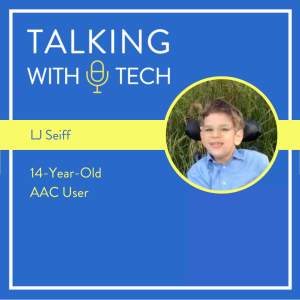
Thursday Apr 20, 2023
Thursday Apr 20, 2023
This week, Chris and Rachel get the opportunity to interview the amazing LJ Seiff! LJ is a 14 year old boy with cerebral palsy and cortical visual impairment, which impact his ability to speak intelligibly. LJ shares about his AAC journey and some of the things that he wishes were done in the classroom more, like giving him more wait time to respond or asking multiple choice questions, since an AAC user can respond with a single press of “a” “b” or “c”.
Before the interview, Chris, Tucker, and Melissa Bugaj have a family discussion of Tucker’s recent playing in the pep band for the Special Olympics at a local school. Tucker chats about what interested him in being a part of the pep band, and shares a sweet story of helping a boy join into a group picture by giving him a chance to use a sousaphone.
Key ideas this week:
🔑One of LJ’s biggest frustrations in the classroom is when teachers don’t think about incorporating or using his device in the classroom setting. He also gets frustrated when staff and teachers do not give him the wait time that is written in his IEP.
🔑LJ doesn’t enjoy when people talk bout him right in front of him as if he wasn’t there. People will also touch his device without permission, which LJ says makes him feel powerless because he can’t say “no” when people don’t ask.
🔑A lot of times there’s focus on literacy, but not as much focus on the needs for students who can do more advanced math. LJ had a lot of words that he needed for his math classes that were not available on his device and that he had add himself.
Links from this week
Equatio - Digital equation editor that can work with speech to text or text to speech. https://www.texthelp.com/products/equatio/
Blog post by LJ about his AAC journey: https://lessonsfromthebigtoe.com/2021/06/24/lj-seiffs-aac-journey/
Visit talkingwithtech.org to access previous episodes, resources, and CEU credits that you can earn for listening to TWT episodes!
Help us develop new content and keep the podcast going strong! Support our podcast at patreon.com/talkingwithtech!
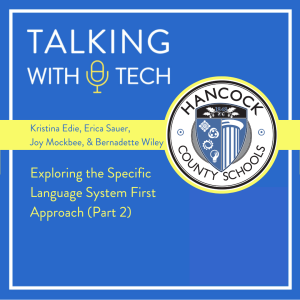
Thursday Apr 13, 2023
Thursday Apr 13, 2023
This week, we share Part 2 of Chris’s conversation with Kristina Edie (SLP), Erica Sauer (Director of Special Programs), Joy Mockbee (OT), and Bernadette Wiley (PT/AAC) with Hancock County Schools in West Virginia. They continue to talk with Chris about the Specific Language System First approach and how it might work for their district, including how to choose the “tier 1/2” device that you give every AAC user.
Before the interview, Rachel shares about working with a new client who has had some difficulty with implementation over the last 5 years with other therapists. Her client’s school-based SLP recently recommended that the AAC User should go to a paper based book to communicate. The SLP said Rachel’s client wasn’t using the device “functionally” because he sometimes hit different buttons and treated the device like a “toy”. When Rachel got a chance to work with the student, she was blown away by all of the ways that this AAC User can communicate, and Rachel was frustrated that he was being denied robust AAC when the problem is poor implementation.
Key Ideas This Week:
🔑 The Hancock team asks Chris about choosing an AAC device for the district that uses Symbol Stix, like TouchChat or Proloquo2Go, because they often use those symbols in class as part of Unique Learning Systems. Chris notes that, in his experience, if we are good at modeling and descriptive teaching, then we can teach any robust system to AAC Users, regardless of how familiar they already are with the pictures.
🔑 One benefit of learning how to model really well on one AAC system is you are able to learn your next AAC system faster, because you already understand the key functions of AAC software in general.
🔑 Chris shares that, with AAC, you need to hit the “sweet spot” that includes an appropriate AAC tool, training for the circle of support on modeling/descriptive teaching, and hands on coaching on how to model effectively.
Links from this Episode:
Continuum of Language Expression (http://bit.ly/colegooglesheets & http://bit.ly/lcpscolepiktochart)
Chris and Rachel discuss the Continuum of Language Expression (COLE) during the banter of this episode of Talking with Tech: https://www.talkingwithtech.org/episodes/julie-freed
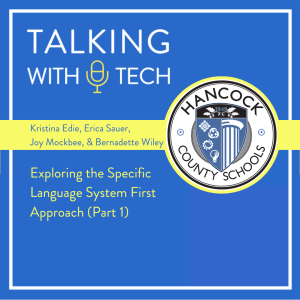
Thursday Apr 06, 2023
Thursday Apr 06, 2023
This week, we share Part 1 of Chris’s conversation with Kristina Edie (SLP), Erica Sauer (Director of Special Programs), Joy Mockbee (OT), and Bernadette Wiley (PT/AAC) with Hancock County Schools in West Virginia. They talk about the AAC journey their district has gone on that led them to asking Chris to help them understand the Specific Language System First approach and how it might work for them.
Before the interview, Chris and Rachel talk about an email that Rachel sent to her email list about using slang with AAC that was offensive to a reader for cultural reasons. Rachel shares about that learning moment, and how it has informed her approach to slang, including being more mindful about taking with families and peers about the slang she wants to add onto a device.
Key ideas this week:
🔑 There is a rationale and reasoning behind the pictures on LAMP Words for Life, and often the picture relates to teaching the concept, like a picture of a dog for “come” or a bridge with a cloud over it for prepositions. It may not always make sense at first, but there is always a thought out reason for the picture, and at the end of the day the student will learn the motor plan regardless of the picture.
🔑 Chris has seen a trend of students wanting to move from LAMP Words for Life to TouchChat in secondary school because they want something that is more text based. Chris shares some have said more text based AAC looks "more mature." Chris points out that adults use images like emojis and gifs all the time, and there should be nothing inherently more “adult” about using text vs using images.
🔑 Slang isn’t as simple as the popular words or phrases that we hear being used on TikTok. These are words that have history and uses that are cultural, regional, and generational in nature. As therapists, we need to be seeking information by initiating conversations with families and peers about the kinds of slang we’re programming into devices.
Visit talkingwithtech.org to access previous episodes, resources, and CEU credits that you can earn for listening to TWT episodes!
Help us develop new content and keep the podcast going strong! Support our podcast at patreon.com/talkingwithtech!

Monday Apr 03, 2023
Monday Apr 03, 2023
In this episode of Talking with Tech, Chris interviews Bruce Alter, a pediatric Physical Therapist and AT Consultant with the Tigard-Tualatin School District in Oregon. Bruce has a long history working with technology, including as a user; he was an early adopter of assistive technology in school to support his challenges with dyslexia. Bruce and Chris’s discussion focuses on artificial intelligince (AI) like Open AI's Chat GPT, including some of the uses it can have in the schools and some applications for AAC users in general.
Before the interview, Chris and Rachel get together with Rachel's twin Matt Madel to talk about Rachel and his connection as twins and some of the ways that he uses Chat GPT in his own work, including quickly creating code in Python.
Key ideas this week:
🔑 ChatGPT is a language model developed by OpenAI that is designed to generate human-like text responses to natural language inputs. It can do more than just answer informational questions - it can write unique code, create formulas for Excel, respond at a particular Lexile level or grade, and more!
🔑 Bruce emphasizes that ChatGPT does not answer questions the same way that a human being does. ChatGPT is known to have "hallucinations" that sound convincing but are factually incorrect. We should teach students that they need to fact check what ChatGPT says to ensure it is correct!
🔑 Should school districts block or ban something that will be available to society, like chat GPT, or do they have a duty to help students figure out how to help students use it? You have to balance students getting their own skills at writing while also teaching them how to utilize tools like GPT to improve their learning.
Links from this week’s episode:
Cult of Pedagogy Podcast: How to Use ChatGPT as an Example Machine https://www.cultofpedagogy.com/chatgpt-example-machine/
Visit talkingwithtech.org to access previous episodes, resources, and CEU credits that you can earn for listening to TWT episodes!
Help us develop new content and keep the podcast going strong! Support our podcast at patreon.com/talkingwithtech!
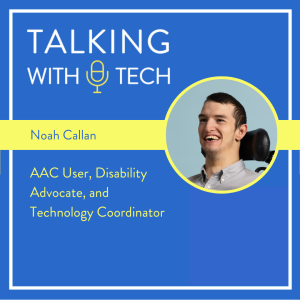
Thursday Mar 23, 2023
Thursday Mar 23, 2023
This week, Rachel and Chris interview Noah Callan, a 25-year-old disability and inclusion advocate who is a full-time AAC user. Noah is also the AAC & Technology Coordinator at Kids+ in Australia. Noah shares about his AAC journey, including some of the changes he has made over the years, such as going from switch access scanning to using an eye gaze camera with Gridpad 12 . Noah also shares some challenging and rewarding experiences he recently had with able-bodied people, including a worker at a bank who refused to talk to him and assumed that he was not intelligent because he is nonspeaking.
Before the interview, Chris and Rachel reflect on how much gestalt language processing (GLP) was a topic of discussion at this year’s ATIA. They note that it continues to be important to ask the right questions and keep an open mind about something you are learning about, while also noting that we need to maintain appropriate skepticism. They also note that the strategy of adding a script to a device could be considered “key vocabulary”.
Key ideas this week:
🔑 If you are a family member, friend, or therapist of an AAC user, try and set a time with the AAC user to have a chat with the device each day. That way, the AAC user feels more comfortable starting their own conversations down the road.
🔑 Noah really likes his current AAC setup on a Gridpad 12 by SmartBox with an eye gaze camera. He likes the Gridpad because: it has a long battery life (10 hours with eye gaze), he likes that the design is not too big or small, and it has an option for a 2nd screen to display what he types. One good feature of the 2nd screen is, while Noah is writing his message, three dots display to help others wait while Noah composes his message.
🔑 Noah says: “Don’t underestimate what an AAC user can do. Give them all the time to deliver their message, because, what is the rush? There is absolutely no rush. Sometimes, people assume that, because I have a physical disability and am nonverbal, I can’t do things like ordinary people do. Before you judge a disabled person, you might want to take the time to get to know them and see what they are able to do. You might be surprised and also find a new friend!”
Links this week:
Noah’s Linktree has links to the programs he is involved in and work he has done, including Kids+ and Get Skilled Access: https://linktr.ee/noahcallan
Visit talkingwithtech.org to access previous episodes, resources, and CEU credits that you can earn for listening to TWT episodes!
Help us develop new content and keep the podcast going strong! Support our podcast at patreon.com/talkingwithtech!

Wednesday Mar 15, 2023
Wednesday Mar 15, 2023
This week on Talking with Tech, Chris and Rachel discuss some of their takeaways from the Assistive Technology Industry Association Conference 2023. For those not familiar, ATIA holds a conference in Florida each year that focuses on assistive technology. Chris has attended and presented at ATIA for years, and Rachel has presented each of the last two years. Chris and Rachel touch on many of the topics they talked about with AAC users, including compensation for AAC Ambassadors, the need for more AAC users in AAC companies, ways that artificial intelligence can impact AAC, and more!
Key ideas this week:
🔑 We wouldn’t have a women’s rights group run by men, but most, if not all, AAC companies do not have an AAC user in an executive-type position in the company. The position that AAC users often fill is an “Ambassador” at conferences, which often pays very little. Chris and Rachel wonder if we can’t do a better job of compensating AAC users equitably for their involvement.
🔑 An AAC user at ATIA brought up that there aren’t always voice options for men, women, teens, children, and people who speak different dialects (e.g. African-American). Chris will start weighting voice options more when considering which AAC app to recommend.
🔑 When we are sharing or presenting, it is important to attribute ideas and images to the person who created them. Attribution allows people to find out about other content creators within the community. If you aren't sure who created something you want to share or use, try to a bit of research into who created it.
Visit talkingwithtech.org to access previous episodes, resources, and CEU credits that you can earn for listening to TWT episodes!
Help us develop new content and keep the podcast going strong! Support our podcast at patreon.com/talkingwithtech!
Links from this Episode:
Futurepedia.io - Contains a large database of AI tools that is updated daily
SLPs as AAC Gatekeepers by Jordyn Zimmerman

Wednesday Mar 08, 2023
Wednesday Mar 08, 2023
This week, Rachel interviews Marcella, the mother of an autistic boy, about the journey Marcella went through to give her son access to high-tech AAC. Marcella previously reached out to Rachel for a coaching call because she was not getting a positive response about AAC when meeting with local SLPs. Marcella decided to take Rachel’s AAC Ally course and started supporting her son’s language development on her own! Marcella shares about some of the benefits of high-tech AAC for her son, including his increased vocalizations and more spontaneous communication about things like feelings.
Before the interview, Chris and Rachel chat about making their own GIF using unscreen.com. They go over how to make a GIF, how you can make a library of GIFs, and ways that GIFs can be used to support AAC users.
Key ideas this week:
🔑 When a child says a word on their device that we think wasn’t what they meant (e.g. “I want pasta” for breakfast), we don’t want to say “no, try again”. Hearing “no” constantly can be frustrating and demotivating. Instead, you can recognize the communication attempt and respond to it with something like “Oh, OK, you can have pasta later for dinner, but what should we eat for breakfast?”.
🔑 We need to presume potential for everyone, not just complex communicators! We should presume that we can all become better communication partners for AAC users with enough practice and effort.
🔑 Marcella’s son says a lot more words now to communicate than he did before using AAC, including saying “up” when he wants to be picked up. This is just another example that AAC helps, rather than hurts, language production.
You can find out more about Marcella and her son on Instagram at https://www.instagram.com/smilethru_
Visit talkingwithtech.org to access previous episodes, resources, and CEU credits that you can earn for listening to TWT episodes!
Help us develop new content and keep the podcast going strong! Support our podcast at patreon.com/talkingwithtech!
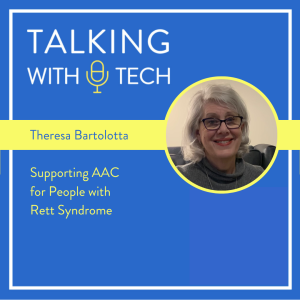
Wednesday Mar 08, 2023
Wednesday Mar 08, 2023
This week, Rachel interviews Dr. Theresa Bartolotta, an SLP who is a parent to Lisa, a young girl with Rett syndrome. Dr. Bartolotta is co-author of the recently published Rett Syndrome Communication Guidelines and serves as consultant on communication to the International Rett Syndrome Foundation (ISRF). Dr. Bartolotta shares about putting together the Rett Syndrome Communication Guidelines, her journey as a parent of a child with Rett, and the IRSF’s mission to spread the word about Rett to more SLPs, teachers, and families.
Before the interview, Rachel and Chris chat about Chris’s GIPHY.com channel, using GIFs to do a deep dive into a client’s specific interests, putting together your own collection of GIFs to use in therapy, and more!
Key ideas this week:
🔑 Rett Syndrome is a genetic disorder caused by an X-linked genetic mutation that affects multiple systems. Communication is usually affected, and people with Rett are typically nonspeaking.
🔑 People with Rhett syndrome often have difficulty regulating their bodies, and go in and out of being overstimulated and understimulated. The Rett Syndrome Communication Guide includes information on how to recognize when someone with Rett is overstimulated (or understimulated), and how to get them back to a regulated state.
🔑 It was important for Dr. Bartolotta to put together the Rett Communication Guidelines, because Rett is such a low-incidence disorder. An SLP working in the schools, for example, might only come across Rett once or twice in an entire career. By providing more information in one place, it can help bridge the knowledge gap for people new to treating Rett.
Links this week:
Chris’s GIF channel on GIPHY: https://giphy.com/channel/christopherbugaj
Rett Syndrome Communication Guidelines https://www.rettsyndrome.org/communication-guidelines/
International Rett Syndrome Foundation rettsyndrome.org.
Free professional development webinar series about Rett by the IRSF: https://www.rettsyndrome.org/for-communication-professionals/
Safe Harbor: A Podcast for Parents of Children with Disabilities: https://www.buzzsprout.com/1909282
Visit talkingwithtech.org to access previous episodes, resources, and CEU credits that you can earn for listening to TWT episodes!
Help us develop new content and keep the podcast going strong! Support our podcast at patreon.com/talkingwithtech!
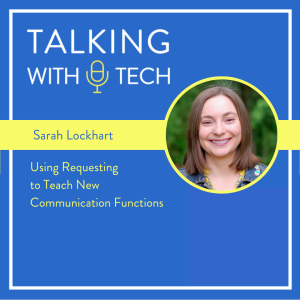
Wednesday Feb 22, 2023
Wednesday Feb 22, 2023
This week, Rachel has a coaching call with Sarah Lockhart, an SLP and host of the SLP Happy Hour podcast! They discuss a case study of a 5 year old nonspeaking boy who uses an AAC device to communicate. Sarah and Rachel discuss concerns that he is “stuck at requesting”, since he typically only makes requests during therapy. Rachel shares how we can lean into those requests and elicit communication using those high-interest topics.
Before the interview, Chris shares with Rachel about his recent trip to Disneyland and some of the thoughts he had during the trip, including: the fact that he didn’t see any people using AAC in 5 days at a busy park; seeing a knit cap someone wore that said “I have autism, please be patient”; and the need to program phrases an AAC user might want to say in public, like “Go Bills”, into their devices.
Key ideas this week:
🔑 If you are trying to introduce commenting, you can set up a carrier phrase like “Its a train!” “Its a train!” “Its a _______” to help set up the expectation rather than just showing a picture of a train. The emphasis and routine can help students become more spontaneous and independent.
🔑 Some people with autism can get really anxious and want to know what is coming next. It can create peaks and valleys in their emotional experience - a visual schedule can help with that. To follow their lead during therapy and not be too rigid, you can include more general things on the schedule, like “read a book or new game”, to allow for adjustments during the session.
🔑 There is a lot of work to be done with coaching communication partners, and it can feel overwhelming. Instead of thinking about everything that needs to be try, try and focus teaching a communication partner to do one thing, and do it well. That can sometimes feel more doable for the both the clinician and the communication partner.
Visit talkingwithtech.org to access previous episodes, resources, and CEU credits that you can earn for listening to TWT episodes!
Help us develop new content and keep the podcast going strong! Support our podcast at patreon.com/talkingwithtech!
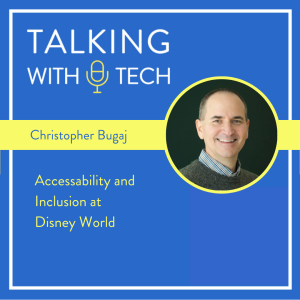
Thursday Feb 16, 2023
Thursday Feb 16, 2023
This week, Chris and Rachel forgo the normal interview format to discuss some of the many thoughts that Chris put together during his recent trip to Disney World, including the need for training Disney Castmembers about ablest language, the need for sensory safe experiences on loud rides, using google images to translate foreign languages, and more!
🔑 Chris discusses the “spoon theory” from a blog post by Christine Miserandino, including the idea that some people don’t have unlimited energy for medical reasons and have to make choices about what they do next. For some of our students, timing matters when it comes to therapy; Rachel wishes that she didn’t have to wait until after school when students are tired to do her therapy.
🔑 When Chris got a tour of Disney World, he asked the tour guide if she had training about language to use related to people with disabilities. The tour guide said they were trained about gender and cultural differences, but they were not trained in how to speak about people with disabilities.
🔑 Chris noticed that there were not always closed captions on videos when standing in line at Disney, and he wonders if it would be helpful for Disney to put together an accessibility team to evaluate how to make the park more fully inclusive.
Links from this Episode
Dan Pink’s book, When - https://www.danpink.com/books/when/
Christine Miserandino’s Spoon Theory blog - https://butyoudontlooksick.com/articles/written-by-christine/the-spoon-theory/
Visit talkingwithtech.org to access previous episodes, resources, and CEU credits that you can earn for listening to TWT episodes!
Help us develop new content and keep the podcast going strong! Support our podcast at patreon.com/talkingwithtech!
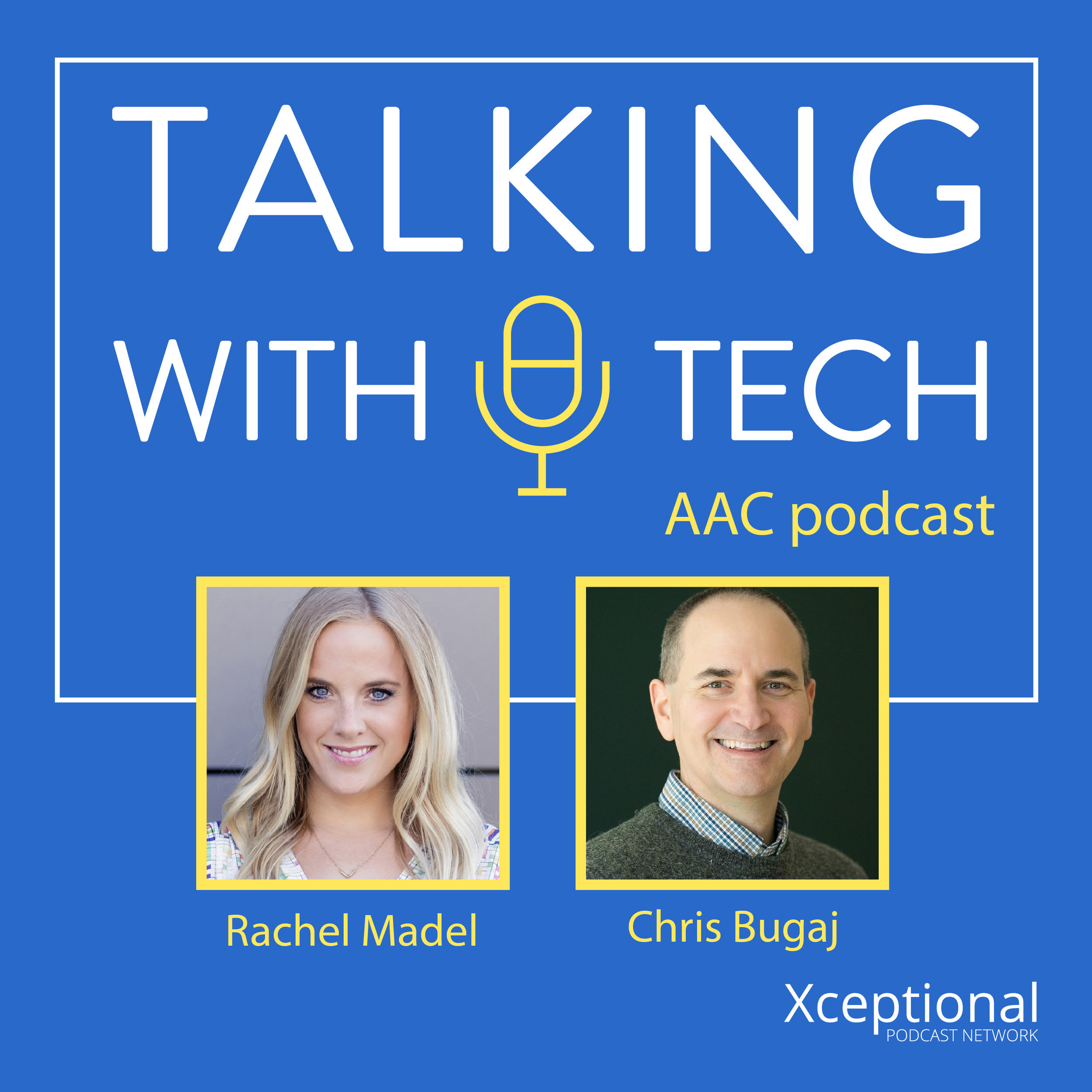
Join AAC experts Rachel Madel and Chris Bugaj as they dive into a weekly discussion about all things AAC (Augmentative and Alternative Communication). Every episode they deliver practical resources, clinical guidelines and relevant research to help clinicians better utilize technology for individuals with complex communication needs.
Episodes include interviews with industry thought-leaders, clinicians, parents, researchers and app developers to keep you on the pulse of the educational technology scene and better support communication through the use of technology.


